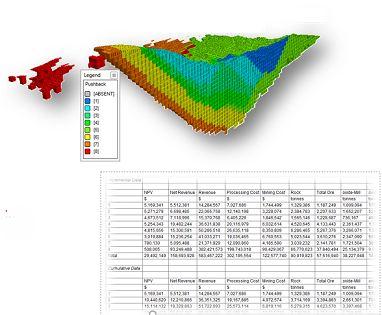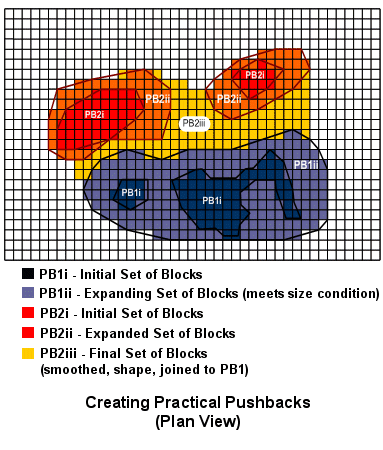What is a Pushback?
In simple terms, a 'pushback' refers to a designated zone representing an area to be mined as a single operation, in terms of accounting.
Your product quickly and automatically generates practical pushbacks, meaning many alternative designs can be considered.
Cross-sectional view of pushback model
Once the Ultimate Pit OES has been established, the pushback generation can commence. The basic objective is to create a pushback shape which meets some primary targets, namely the ore tonnage to be won from each pushback as well as its minimum mining width.
- The Ultimate Pit OES is used as an input to the Pushback Generator.
- The objective of the pushback generator is to create pushback shapes which meet a primary target such as ore tonnage whilst honouring constraints such as minimum mining width, depth and position.
- Pushback shape, size, and location can be controlled using imported or defined boundaries.
- The Ultimate Pit OES is used to provide contiguous blocks of ore that define practical mining shapes which are adjusted to meet the physical criteria of the pushbacks.
- Various pushback control boundaries are supported.
The other parameters which can be set include mining constraints on the maximum number of pushbacks generated as well as some more general parameters for making the pushbacks practical. These include:
-
Defining the feasible size of the “remnants” between a pushback and the ultimate pit that must be included so that later mining need not return to capture this ore.
-
Defining the “smoothness” of the pit walls to make the shape practical to blast and mine.
-
In addition the pushback can be directed to include the area of its predecessor or consist of contiguous blocks.
The generator then creates the pushbacks by re-sorting the OES to get contiguous blocks of ore that create a practical mining shape. These are accumulated in different combinations and the different combinations are compared until an optimum is found. This process has already been “pre-conditioned” by the way in which the OES was created with the proximity values which tended to group the ore into contiguous blocks.
Because of this approach the generation of different pushback strategies is correspondingly rapid while the remnants and smoothing ensure that the result will produce a pit that has access, size and a practical shape while at the same time meeting the ore tonnage criterion.
The diagram below shows the steps by which the pushback generator selects blocks for the pushback, joins them together to form contiguous shapes, takes the remnant blocks into the pushback shape and then joins the two pushbacks so that they form practical mining strategies:
For example, PB2i represents a grouped sequence of blocks established by the Optimal Extraction Sequence. These groupings are expanded to create PB2ii by including later sequenced blocks so that a specific ore tonnage condition for the second pushback is achieved. The further addition of blocks to create PB2iii successfully joins pushback 2 to the previous pushback and creates smooth edges.
It should be noted that any one pushback shape that is generated in this process will seldom, if ever, be mined as one project where mining only starts in that pushback after the previous pushback has been fully extracted. In short, while a pushback is very definitely a physical mining shape, it is never a shape that occurs at one point in time during the mine’s life. This is because as the ore mined by each pushback lies deeper it needs to be pre-stripped during the periods when previous pushbacks are being mined.
The importance of the pushback shapes therefore is that rather than being the physical stages in a mine design they form economic boundaries about which management decisions must be made regarding the mine life. Because of the requirement for pre-stripping in advance of mining it is often necessary to make a decision about whether a pushback should be extracted years in advance of ore being removed from it.
Once an extraction sequence has been calculated, taking practical considerations into account, it is possible to schedule the pushbacks.



